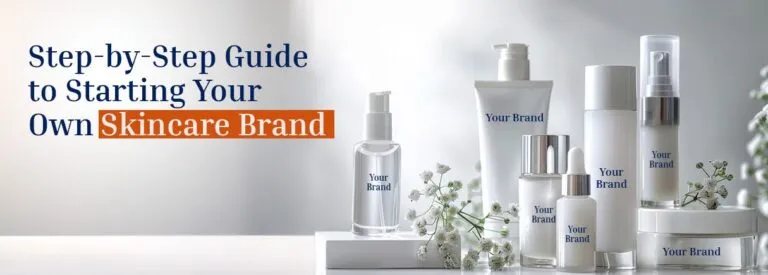Step-by-Step Guide to Starting Your Own Skincare Brand

The Indian skincare market is projected to reach $2.68 billion by 2025, presenting unprecedented opportunities for entrepreneurs. Starting your own skincare brand requires careful planning, strategic partnerships, and understanding of manufacturing landscapes across different states. This comprehensive guide will walk you through essential steps to launch your successful skincare venture.
Step 1: Market Research and Brand Positioning
Begin with thorough market analysis to identify your target audience, competitors, and unique selling proposition. The skincare industry is witnessing significant growth with consumers increasingly seeking natural, effective, and affordable products.
Define your brand’s mission, values, and positioning in the competitive landscape. Research consumer preferences, price points, and emerging trends like clean beauty, anti-aging solutions, and sustainable packaging.
Step 2: Product Development and Formulation
Collaborate with experienced cosmetic product manufacturing companies to develop your initial product line. Start with 3-5 core products focusing on specific skin concerns rather than overwhelming consumers with extensive ranges.
Consider working with cosmetic manufacturing companies that offer R&D services, helping you create unique formulations that align with your brand vision and target market needs.
Step 3: Choosing the Right Manufacturing Partner
Selecting appropriate manufacturing partners is crucial for your brand’s success. India offers diverse manufacturing hubs across different states:
Northern Region: Cosmetic manufacturers in Delhi provide excellent connectivity and access to raw materials. Third party cosmetic manufacturers in Delhi offer comprehensive services from formulation to packaging.
Western Region: Cosmetic manufacturers in Gujarat are known for cost-effective production and quality standards. The state’s industrial infrastructure supports large-scale manufacturing operations.
Third party cosmetic manufacturers in Mumbai leverage the city’s business ecosystem and port connectivity for import-export advantages. Third party cosmetic manufacturers in Pune offer proximity to research institutions and skilled workforce.
Southern Region: Cosmetic manufacturers in Karnataka benefit from the state’s focus on biotechnology and innovation, making them ideal for advanced skincare formulations.
Step 4: Regulatory Compliance and Licensing
Ensure compliance with Bureau of Indian Standards (BIS) regulations and obtain necessary licenses. Register your products under the Drugs and Cosmetics Act, 1940, and secure manufacturing licenses if required.
Top third party cosmetic manufacturers in India typically handle regulatory compliance, but understanding requirements helps in making informed decisions about partnerships and product claims.
Step 5: Branding and Packaging Design
Develop compelling brand identity including logo, packaging design, and marketing materials. Your packaging should reflect your brand values while ensuring product protection and shelf appeal.
Many cosmetic manufacturing companies offer packaging services, providing one-stop solutions from formulation to final product delivery.
Step 6: Quality Assurance and Testing
Implement rigorous quality control measures throughout the manufacturing process. Ensure your manufacturing partner follows Good Manufacturing Practices (GMP) and conducts necessary safety and efficacy testing.
Establish quality parameters for raw materials, in-process monitoring, and finished product testing to maintain consistent quality standards.
Step 7: Digital Marketing and E-commerce Setup
Create strong online presence through professional website, social media channels, and e-commerce platforms. Digital marketing is essential for reaching target audiences and building brand awareness.
Develop content marketing strategies showcasing product benefits, ingredient transparency, and brand story to engage potential customers effectively.
Step 8: Distribution Strategy
Plan your distribution channels including online marketplaces, retail partnerships, and direct-to-consumer sales. Start with focused distribution to test market response before expanding.
Consider partnering with beauty retailers, salons, and wellness centres to increase product visibility and accessibility.
Step 9: Financial Planning and Investment
Prepare detailed financial projections including manufacturing costs, marketing expenses, and working capital requirements. Most skincare start-ups require initial investment ranging from ₹5-25 lakhs depending on product range and scale.
Explore funding options including personal savings, angel investors, venture capital, or government schemes supporting start-up ventures.
Step 10: Launch and Scale
Execute soft launch with limited product range to gather customer feedback and refine offerings. Monitor sales performance, customer reviews, and market response to make necessary adjustments.
Plan scaling strategies including expanded product lines, new market penetration, and enhanced manufacturing partnerships as your brand grows.
Frequently Asked Questions
Q: Which cosmetic manufacturers in different states offer the best services for start-ups? A: Ans: Delhi, Gujarat, Karnataka, Mumbai, and Pune all have excellent manufacturers with varying specializations and cost structures.
Q: What’s the minimum investment required to start a skincare brand in India?
Ans: Initial investment typically ranges from ₹5-25 lakhs depending on product range, packaging, and marketing requirements.
Q: How do I choose between different third party cosmetic manufacturers?
Ans: Consider factors like quality certifications, production capacity, customization options, location advantages, and cost structure.
Q: What regulatory approvals are needed for skincare products in India?
Ans: Products require registration under Drugs and Cosmetics Act, BIS compliance, and appropriate manufacturing licenses.
Q: How long does it take to launch a skincare brand from concept to market?
Ans: Typically, 6-12 months including product development, regulatory approvals, branding, and manufacturing setup.
Q: Can I start with a single product and expand gradually?
Ans: Yes, starting with 1-3 core products is recommended to test market response before expanding your product portfolio.
